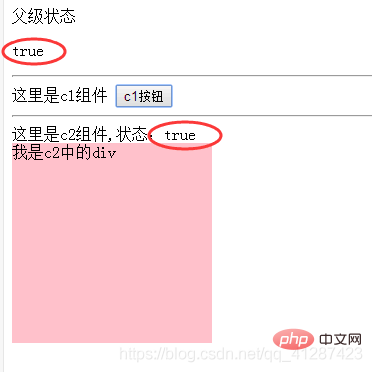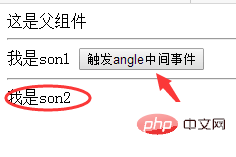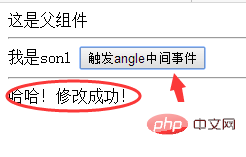Home >Web Front-end >Vue.js >What are the five ways to pass values in vue components?
Five ways to pass values in vue components: 1. Parent component passes value to child component; 2. Child component passes value to parent component; 3. Passes parameters between adjacent sibling components; 4. Parameters are passed between distant sibling components; 5. EventBus parameters are passed.

The operating environment of this tutorial: windows7 system, vue2.9.6 version, DELL G3 computer.
Parent component passes value to child component:
Subcomponents pass values to parent components:
Pass parameters between adjacent sibling components (brothers)
Passing parameters from distant brothers (cousins)
EventBus passing parameters
Principle : The parent controls the child. Through the props attribute of the child component, it throws the child component's custom label attribute to receive the operating status of the parent component.
Example: A button in the parent controls the display and hiding of a p in the child component.
<!DOCTYPE html>
<html>
<head>
<meta charset="UTF-8">
<title>Document</title>
</head>
<style>
.div{
width:200px;
height:200px;
background:pink;
}
</style>
<body>
<!-- 这里的app范围就是 子组件son 的父级 -->
<div id="app">
<button @click='change'>父按钮</button>
<hr>
<!-- ********** 自定义标签属性test,接收父级的state ************-->
<son :test='state'></son>
</div>
<template id="tp1">
<div>
<!-- ************ 调用自定义属性test **************-->
<div v-show='test'>我是子组件的div</div>
</div>
</template>
<script src="../vue/vue.js"></script>
<script>
// 局部定义 子组件son
new Vue({
el:"#app",
data:{
state:true
},
methods:{
change(){
this.state = !this.state;
}
},
components:{
son:{
template:"#tp1",
//*********** 抛出自定义标签属性 ***************
props:['test']
}
}
})
</script>
</body>
</html>Effect:

Principle: The child controls the parent, and the child component binds custom events. To handle the method function of the parent component, trigger your own custom event through .$emit('custom event',[parameter])
Example: a button in the child component controls a p in the parent component Show hide
<!DOCTYPE html>
<html>
<head>
<meta charset="UTF-8">
<title>Document</title>
</head>
<style>
.div{
width:200px;
height:200px;
background:pink;
}
</style>
<body>
<div id="app">
<c1></c1>
</div>
<!-- 父组件c1 子组件c2 子组件自定义事件test-->
<template id="c1">
<div>
<div v-show='state'>father显示/隐藏</div>
<hr>
<!--************ 子组件c2自定义事件,执行父组件c1的方法函数change_f ***************** -->
<c2 @test='change_f'></c2>
</div>
</template>
<template id="c2">
<div>
<button @click='change_son'>子按钮</button>
</div>
</template>
<!-- 引入Vue.js框架文档,可在官方文档下载-->
<script src='../vue/vue.js'></script>
<script>
//全局定义
// 实例化 父组件c1
Vue.component("c1",{
template:"#c1",
data(){
return {
state:true
}
},
methods:{
change_f(){
this.state = !this.state;
}
}
})
// 实例化 子组件c2
Vue.component("c2",{
template:"#c2",
methods:{
change_son(){
// ************ 在子组件方法里,触发子组件自定义事件 ******************
this.$emit("test")
}
}
})
//实例化一个Vue对象
new Vue({
el:"#app"
})
</script>
</body>
</html>Effect:

Principle: through a public parent The element serves as a bridge (instance component), combined with parent-child props parameter passing and child-parent custom events
Example: c1 and c2 are brothers. c1 can control the display and hiding of elements in c2
<!DOCTYPE html>
<html>
<head>
<meta charset="UTF-8">
<title>Document</title>
</head>
<style>
.div{
width:200px;
height:200px;
background:pink;
}
</style>
<body>
<div id="app">
父级状态
<p>{{state}}</p>
<hr>
<c1 @test_c1='change_f'></c1>
<hr>
<c2 :test_c2='state'></c2>
</div>
<template id="c1">
<div>这里是c1组件
<button @click='change_c1'>c1按钮</button>
</div>
</template>
<template id="c2">
<div>这里是c2组件,状态:{{test_c2}}
<div v-show='test_c2'>我是c2中的div</div>
</div>
</template>
<script src='../vue/vue.js'></script>
<script>
Vue.component("c2",{
template:"#c2",
props:['test_c2']
})
Vue.component("c1",{
template:"#c1",
methods:{
change_c1(){
this.$emit("test_c1")
}
}
})
new Vue({
el:"#app",
data:{
state:true
},
methods:{
change_f(){
this.state = !this.state;
}
}
})
</script>
</body>
</html>Effect :

Principle: By creating an intermediate instance and registering an event, in the controlled component, The function to be executed is carried through the event. In the main control component, the corresponding operation is changed through the event

<!DOCTYPE html>
<html>
<head>
<meta charset="UTF-8">
<title>Document</title>
</head>
<body>
<div id="app">
<father></father>
</div>
<template id="father">
<div>
这是父组件
<hr>
<son1></son1>
<hr>
<son2></son2>
</div>
</template>
<template id="son1">
<div>
{{name}}
<button @click='click_son1'>触发angle中间事件</button>
</div>
</template>
<template id="son2">
<div>
{{name}}
</div>
</template>
<script src='../vue/vue.js'></script>
<script>
//********** 创建一个angle实例,作为中间变量(全局) **************
let angel = new Vue();
new Vue({
el:"#app",
components:{
father:{
template:"#father",
components:{
son1:{
template:"#son1",
data(){
return {
name:"我是son1"
}
},
methods:{
click_son1(){
// *************** 通过angel注册的test事件,修改son2中name的值 ************
angel.$emit('test','哈哈!修改成功!')
}
}
},
son2:{
template:"#son2",
data(){
return {
name:"我是son2"
}
},
methods:{
change(val){
this.name = val;
}
},
//生命周期,自动执行,组件准备ok就可用
mounted(){
// *************** 通过angel注册的test事件,将son1的修改方法传过去 ************
angel.$on('test',this.change)
}
}
}
}
}
})
</script>
</body>
</html>Effect:
Before clicking :

After clicking:

Vue.prototype.$EventBus = new Vue()2.A component
<template>
<div class="wrap">
<div>我是组件A</div>
<button @click="sendMsg">发送</button>
</div>
</template>
<script>
export default {
name: "A",
methods:{
sendMsg(){
this.$EventBus.$emit('sendMsg',"这是组件A发送的消息!")
}
}
}
</script>3.B component<template>
<div>
<div>我是组件B</div>
</div>
</template>
<script>
export default {
name: "B",
mounted(){
this.$EventBus.$on('sendMsg',(msg)=>{
console.log(msg);//这是组件A发送的消息!
})
},
}
</script>Pass parameters by mounting the global Vue object. Related recommendations: "vue.js Tutorial"
The above is the detailed content of What are the five ways to pass values in vue components?. For more information, please follow other related articles on the PHP Chinese website!